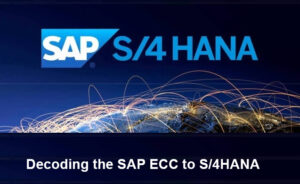Decoding the SAP ECC to S/4HANA Migration
Introduction
In the swiftly evolving realm of business, the backbone of operations is formed by enterprise resource planning (ERP) systems. With SAP ECC reaching its end of support, numerous organizations are standing at a crossroads, confronted with the crucial choice of transitioning to SAP S/4HANA.

This transition brings forth an array of challenges and opportunities, necessitating organizations to navigate between various migration paths. In this article, we will delve into these paths, which include upgrading while retaining the old configuration, embarking on a greenfield implementation on-premises, and fully embracing the prowess of S/4HANA for a futuristic ERP solution.
Upgrading and Preserving the Status Quo
For organizations seeking a more straightforward transition, the option of upgrading their existing SAP ECC system to S/4HANA while retaining the old configuration might hold allure. This alternative allows businesses to uphold their present business processes, minimizing disturbances during migration. However, it is essential to recognize that this approach may not fully unlock the capabilities that S/4HANA offers.
Pros
Cons
Staying On-Premises and Pioneering a Greenfield Implementation
A greenfield implementation involves constructing a new SAP S/4HANA environment from scratch, providing organizations with the chance to reevaluate and optimize their processes. While this choice demands more resources and time, it offers a clean slate to establish a tailored ERP system aligned with the latest best practices and innovations.
Pros
Cons
Embracing the Apex Potential of S/4HANA for a Forward-Looking Cloud-Based Solution
SAP S/4HANA, already a revolutionary force in ERP systems with its streamlined architecture and real-time capabilities, takes on new dimensions when combined with cloud computing. This synergy offers organizations previously untapped possibilities. The cloud’s flexibility, scalability, and accessibility harmonize effortlessly with S/4HANA’s advanced functionalities, ushering in a new era of enterprise management.
Pros
Cons
Conclusion
The transition from SAP ECC to S/4HANA is a substantial undertaking that warrants careful contemplation of available options. Each path presents its own set of advantages and challenges, and the optimal choice hinges on the distinct circumstances and objectives of each organization.
While the “upgrade and retain” option may provide a less disruptive route, it might not tap into the full scope of S/4HANA’s capabilities. The “greenfield implementation” avenue offers a chance to reimagine processes, but demands substantial resources. On the other hand, embracing S/4HANA for a forward-looking solution can propel organizations toward innovation and competitiveness, albeit with a more substantial investment.
Whichever direction a business chooses, meticulous planning, robust change management, and collaboration with seasoned SAP consultants are vital for a successful migration. This decision marks a pivotal moment for organizations to shape their ERP future, laying the groundwork for growth and prosperity in the digital era.


